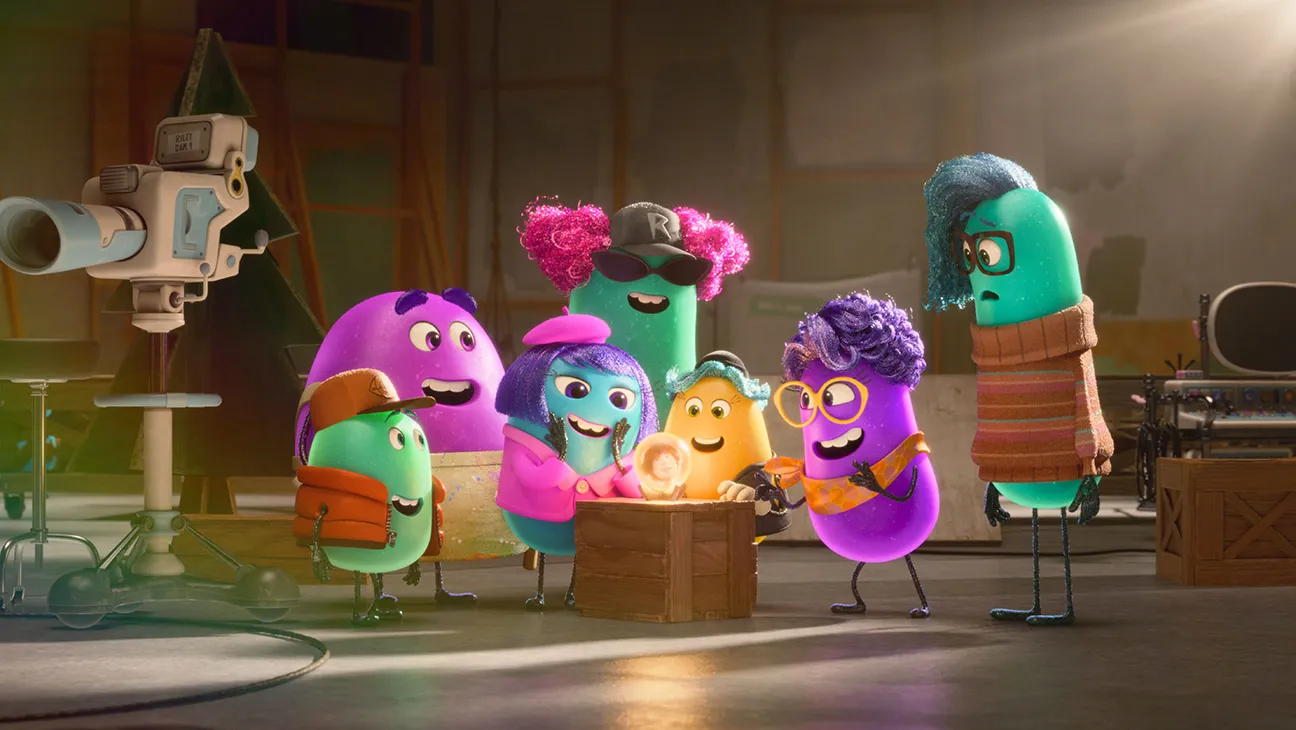Pixar Animation Studios’ latest television series, Dream Productions, based on the highly popular Inside Out franchise, premieres today on Disney+. Described as an “interquel,” the series is set between the 2015 original film and the upcoming 2024 sequel.
The show revisits the inner workings of Riley Andersen’s mind, centering on her “dream director” Paula Persimmon (voiced by Paula Pell) and daydream specialist Xeni (Richard Ayoade), who collaborate in Riley’s dream-making studio to create her next big tween fantasy.
In late October, Cartoon Brew attended a Fredrikstad Animation Festival panel discussing the making of Dream Productions.
The presentation was led by Bill Wise, Pixar veteran and the series’ VFX supervisor, marking the final project of his 30-year career before departing the studio in July. Speaking candidly, Wise shared insights into the production’s unique challenges and triumphs.
“[The making of Dream Productions] is mostly a story about process and people,” Wise explained. “Pixar has long had its own proprietary pipeline, which has its advantages.
However, we had to adapt to the task at hand: creating 140 minutes of feature-quality animation across seven episodes at a fraction of the cost of a feature film.”
Navigating Budget Constraints
Without divulging exact numbers, Wise quantified the workload in terms of labor weeks. “Over the last decade, a typical Pixar movie has had a budget of 18,500 to 22,500 labor weeks.
For Dream Productions, our initial budget was 10,000 weeks. This project was a grand experiment for Pixar, especially with multiple directors collaborating with lead writer and showrunner Mike Jones.
From the beginning, we knew it would overlap production with Inside Out 2, which had already been greenlit.”
To manage these constraints, the team streamlined each department’s workload. “Our writing schedule was aggressive,” Wise noted. “We had nine weeks in the writer’s room and four months of script development.
The goal was to have seven locked scripts upfront—a significant departure from Pixar’s norm. Our production schedule mirrored a feature film’s structure, but with multiple episodes in simultaneous production.
This required tremendous discipline, as we aimed to deliver one-and-a-half times the usual footage with half the budget.”
The team leveraged assets from the original Inside Out and collaborated with the Inside Out 2 production pipeline. “Historically, Pixar operates with isolated ‘islands’ for each film,” Wise explained.
“But given our limited budget, we built boundaries around an existing toolset rather than developing new technologies. We also broke down barriers within our team to foster collaboration.”

Overcoming Early Setbacks
The production faced challenges as early as October 2021, when staffing priorities shifted toward other Pixar projects like Elemental and Lightyear. This caused an eight-month delay in asset creation.
“From the outset, it was made clear we were a lower priority than feature films, especially in terms of staffing resources,” Wise admitted.
Despite these hurdles, the art department, led by art director Bert Berry, built Riley’s dream studio while other teams repurposed and updated characters, backgrounds, and props from the first film. Wise highlighted the innovative use of a shared Perforce server with Inside Out 2.
“This allowed us to exchange assets while focusing our limited resources on unique needs for Dream. However, this also led to friction, as shared assets needed to meet feature-level quality standards despite our tighter iteration constraints.”
A Cultural Shift at Pixar
The production adopted a new workflow, combining departments and integrating daily review sessions involving all technical teams.
“Typically, at Pixar, departments like editing, layout, and animation operate more independently,” Wise explained. “For Dream, we created a collaborative environment where everyone was involved in the creative process from the start.”
This approach resulted in faster production times and greater creative flexibility, enabling the team to complete complex shots with fewer iterations.
Budget Cuts and Layoffs
By early 2023, Disney’s announcement of 7,000 layoffs and a strategic pivot away from streaming dealt a blow to morale. Dream Productions faced a 20% budget cut and was reduced from seven episodes to four.
Wise reflected on the turbulent period: “Our producer, director, and team managers fought hard to keep us on track, even as our budget fluctuated due to staffing shifts back to Inside Out 2.”
Despite the setbacks, Dream Productions wrapped in March 2024, achieving remarkable productivity gains, including a 200% increase in animation output and a 321% rise in lighting efficiency. However, Pixar’s post-production layoffs underscored the studio’s renewed focus on feature films.
“It was another blow for a team that gave everything to this project,” Wise said. “Unfortunately, it seems Pixar hasn’t fully embraced the lessons from Dream Productions.
The success of Inside Out 2 will likely reinforce traditional workflows, but I still believe our collaborative approach unlocked new creative potential.”
The Future of Pixar Television
Dream Productions debuts as Pixar’s second long-form animated series following Win or Lose, which is scheduled for release on February 19, 2025. Beyond these projects, Pixar has shifted its focus back to feature films, with no additional series currently announced.


